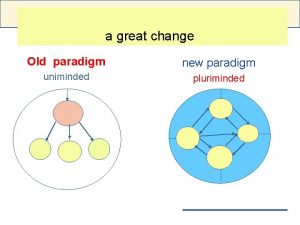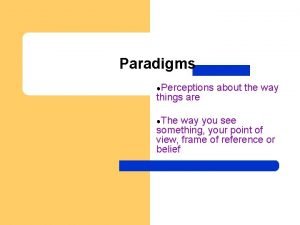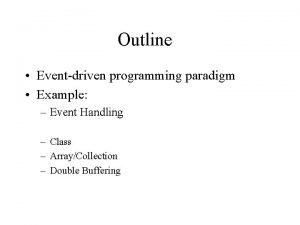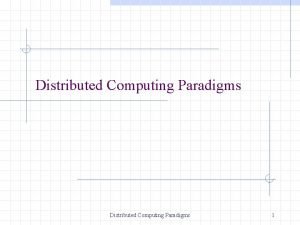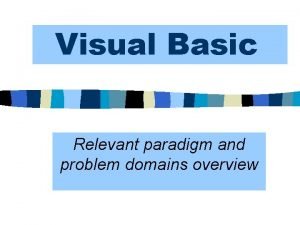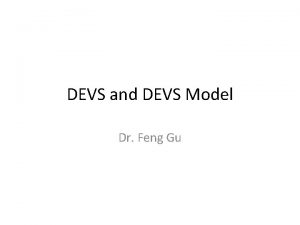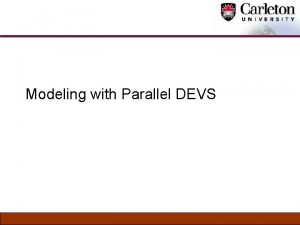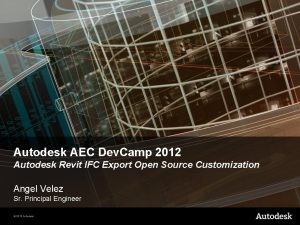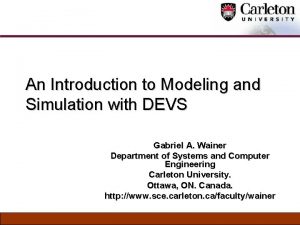Sy DEVS Introduction Theory Paradigm Implementation Autodesk Research

























































- Slides: 57

Sy. DEVS Introduction Theory – Paradigm – Implementation Autodesk Research June 2018

Sy. DEVS is a framework supporting the development and integration of systems analysis and simulation code. Decades of theory on the representation of systems forms a basis for the Sy. DEVS approach. A paradigm has been developed that combines dataflow programming with discrete event simulation, and allows any simulation to be specified in the form of a node graph. To implement a simulation using this approach, nodes are defined as C++ classes which inherit from classes in the Sy. DEVS open source library.

Theory

Theory Sy. DEVS is based on theory that dates back to the late 1960 s. 1970 1980 1990 2000 2010 2020

Theory Here is a small sample of related publications from the last 50 years. 1970 1980 1990 2000 2010 2020

Theory General methods to formally represent systems began with the work of Wayne Wymore. A. Wayne Wymore A Mathematical Theory of Systems Engineering 1967

Theory Bernard Zeigler applied similar ideas to simulation. Bernard P. Zeigler Theory of Modeling and Simulation 1976

Theory He found that essentially all simulations can be represented in a common form based on the discrete event simulation paradigm. Zeigler named this common form "DEVS". Bernard P. Zeigler Theory of Modeling and Simulation 1976

Theory 1970 1980 1990 2000 2010 2020

Theory Over the years, the generality of DEVS was confirmed. It was found that for each of the most common modeling paradigms, any model expressed in that paradigm could also be represented using DEVS. Hans L. M. Vangheluwe DEVS as a Common Denominator… 2000

Theory 1970 1980 1990 2000 2010 2020

Theory In 2011, researchers at Autodesk began exploring how to make DEVS more approachable to scientific and engineering communities. Autodesk Research & Carleton University Formal Languages for Computer Simulation 2011

Theory The process involved several iterations. Autodesk Research Design. DEVS Help Graphic 2012

Theory Eventually, a set of visual interfaces were designed along with a new way of expressing DEVS. Autodesk Research & Simon Fraser University Designing DEVS Visual Interfaces… 2015

Theory 1970 1980 1990 2000 2010 2020

Theory For more information on theory underlying the Sy. DEVS framework, visit the Autodesk Research website and find the "Systems Design & Simulation" project. www. autodeskresearch. com Project: Systems Design & Simulation

Paradigm

Paradigm Sy. DEVS supports a node-based modeling paradigm combining dataflow programming with DEVS.

Paradigm Dataflow programming is a widely used paradigm in which the links between nodes form a directed acyclic graph.

Paradigm Dataflow A node is executed once it receives data on all of its input ports.

Paradigm DEVS To introduce the notion of time into the paradigm, a column of discrete event simulation nodes is incorporated into the graph. Links between these nodes may form cycles.

Paradigm The execution of the entire graph is now partitioned into three phases.

Paradigm Initialization (Dataflow) The first phase is called "Initialization". A dataflow network collects data and converts it into a form suitable for simulation.

Paradigm The second phase is the "Simulation" (or "DEVS") phase. Messages are passed from node to node as time advances. Simulation (DEVS)

Paradigm The third phase is called "Finalization". Another dataflow network is executed to prepare statistics and metrics using data from the simulation nodes. Finalization (Dataflow)

Paradigm There are four types of nodes.

Paradigm Function nodes are the basic type of dataflow node. Function Node Atomic nodes are the basic type of simulation node. Atomic Node

Paradigm Composite nodes contain networks (dataflow + DEVS + dataflow) of other nodes. The contained nodes can themselves be composite nodes, forming a hierarchy. Composite Node

Paradigm Collection Node Collection nodes contain any number of instances of a single type of node. The number of instances can change during a simulation. Collection nodes are useful for agent-based modeling, where each instance is an agent.

Paradigm Nodes 1. Function Node 2. Atomic Node 3. Composite Node 4. Collection Node Here is a list of the four types of nodes.

Paradigm Each type of node contains a particular set of elements.

Paradigm For the purpose of understanding the paradigm, the elements of the atomic node are of key importance. Atomic Node

Paradigm Atomic nodes contain functions for four types of events. Unplanned Event Finalization Event Initialization Event Planned Event

Paradigm The Initialization Event is invoked once, at the beginning of the simulation or (if the node is an agent in a collection node) when the node is created. Unplanned Event Finalization Event Initialization Event Planned Event

Paradigm An Unplanned Event is invoked every time a message is received. The node does not know when it will receive a message; hence these events are "unplanned". The fact a node must always be ready for an incoming message is one of the distinguishing characteristics of DEVS. Unplanned Event Finalization Event Initialization Event Planned Event

Paradigm A Planned Event is essentially scheduled by the node, and hence "planned". It is only during one of these events that a message can be sent. Unplanned Event Finalization Event Initialization Event Planned Event

Paradigm The Finalization Event is invoked once, at the end of the simulation or (if the node is an agent in a collection node) when the node is terminated. Unplanned Event Finalization Event Initialization Event Planned Event

Paradigm The Elapsed Duration is the time elapsed since the previous event. It is available as a source of information for Unplanned, Planned, and Finalization events. For Initialization events, there is no previous event, and hence no Elapsed Duration Initialization Event Elapsed Duration Unplanned Event Elapsed Duration Planned Event Finalization Event

Paradigm The Planned Duration is the time before the next scheduled Planned Event. It is produced by every Initialization, Unplanned, and Planned event, overriding any previously scheduled Planned Event. For Finalization events, there is no next Planned Event, and hence no need to produce a Planned Duration. Unplanned Event Initialization Event Planned Duration Finalization Event Planned Duration

Paradigm Nodes Events 1. Function Node 1. Initialization Event 2. Atomic Node 2. Unplanned Event 3. Composite Node 3. Planned Event 4. Collection Node 4. Finalization Event Here are lists of the four types of nodes and four main types of events.

Implementation

Implementation Sy. DEVS is an open source C++ library that supports modeling and simulation using the previously described dataflow + DEVS + dataflow paradigm. The main Sy. DEVS website is at the following URL: https: //autodesk. github. io/sydevs

Implementation The Overview page on the website illustrates the four types of nodes.

Implementation The Getting Started tutorial guides users through the process of setting up a Sy. DEVS project and running simulations.

Implementation There is also an API Reference.

Implementation At present, there is no visual programming interface. Node graphs similar to the one shown must be defined in C++ using Sy. DEVS classes.

Implementation Suppose one wishes to implement an atomic node. Atomic Node

Implementation They would then write a C++ class that inherits from the atomic_node base class provided by the Sy. DEVS library. class queueing_node : public atomic_node { public: // Constructor/Destructor: queueing_node(const std: : string& node_name, const node_context& external_context); virtual ~queueing_node() = default; // Attributes: virtual scale time_precision() const { return micro; } // Ports: port<flow, input, duration> serv_dt_input; port<message, input, int 64> job_id_input; port<message, output, int 64> job_id_output; port<flow, output, duration> idle_dt_output; protected: // State Variables: duration serv_dt; std: : vector<int 64> Q; duration idle_dt; duration planned_dt; // // service duration job ID (input) job ID (output) idle duration service duration (constant) queue of IDs of jobs waiting to be processed idle duration (accumulating) planned duration // Event Handlers: virtual duration initialization_event(); virtual duration unplanned_event(duration elapsed_dt); virtual duration planned_event(duration elapsed_dt); virtual void finalization_event(duration elapsed_dt); };

Implementation class queueing_node : public atomic_node { public: // Constructor/Destructor: queueing_node(const std: : string& node_name, const node_context& external_context); virtual ~queueing_node() = default; // Attributes: virtual scale time_precision() const { return micro; } // Ports: port<flow, input, duration> serv_dt_input; port<message, input, int 64> job_id_input; port<message, output, int 64> job_id_output; port<flow, output, duration> idle_dt_output; Observe there are four types of ports. protected: // State Variables: duration serv_dt; std: : vector<int 64> Q; duration idle_dt; duration planned_dt; // // service duration job ID (input) job ID (output) idle duration service duration (constant) queue of IDs of jobs waiting to be processed idle duration (accumulating) planned duration // Event Handlers: virtual duration initialization_event(); virtual duration unplanned_event(duration elapsed_dt); virtual duration planned_event(duration elapsed_dt); virtual void finalization_event(duration elapsed_dt); };

Implementation Here they are in the diagram. Atomic Node

Implementation Each type of port is associated with one of the four main types of events. Unplanned Event Finalization Event Initialization Event Planned Event

Implementation class queueing_node : public atomic_node { public: // Constructor/Destructor: queueing_node(const std: : string& node_name, const node_context& external_context); virtual ~queueing_node() = default; // Attributes: virtual scale time_precision() const { return micro; } // Ports: port<flow, input, duration> serv_dt_input; port<message, input, int 64> job_id_input; port<message, output, int 64> job_id_output; port<flow, output, duration> idle_dt_output; protected: // State Variables: duration serv_dt; std: : vector<int 64> Q; duration idle_dt; duration planned_dt; The code to be executed for each type of event is placed in these four member functions. // // service duration job ID (input) job ID (output) idle duration service duration (constant) queue of IDs of jobs waiting to be processed idle duration (accumulating) planned duration // Event Handlers: virtual duration initialization_event(); virtual duration unplanned_event(duration elapsed_dt); virtual duration planned_event(duration elapsed_dt); virtual void finalization_event(duration elapsed_dt); };

Implementation class queueing_node : public atomic_node { public: // Constructor/Destructor: queueing_node(const std: : string& node_name, const node_context& external_context); virtual ~queueing_node() = default; // Attributes: virtual scale time_precision() const { return micro; } // Ports: port<flow, input, duration> serv_dt_input; port<message, input, int 64> job_id_input; port<message, output, int 64> job_id_output; port<flow, output, duration> idle_dt_output; protected: // State Variables: duration serv_dt; std: : vector<int 64> Q; duration idle_dt; duration planned_dt; // // service duration job ID (input) job ID (output) idle duration service duration (constant) queue of IDs of jobs waiting to be processed idle duration (accumulating) planned duration // Event Handlers: virtual duration initialization_event(); virtual duration unplanned_event(duration elapsed_dt); virtual duration planned_event(duration elapsed_dt); virtual void finalization_event(duration elapsed_dt); Observe that three of the functions have time duration arguments. };

Implementation These are the Elapsed Durations. Elapsed Duration Initialization Event Elapsed Duration Unplanned Event Elapsed Duration Planned Event Finalization Event

Implementation As for the Planned Durations… Unplanned Event Initialization Event Planned Duration Finalization Event Planned Duration

Implementation class queueing_node : public atomic_node { public: // Constructor/Destructor: queueing_node(const std: : string& node_name, const node_context& external_context); virtual ~queueing_node() = default; // Attributes: virtual scale time_precision() const { return micro; } // Ports: port<flow, input, duration> serv_dt_input; port<message, input, int 64> job_id_input; port<message, output, int 64> job_id_output; port<flow, output, duration> idle_dt_output; protected: // State Variables: duration serv_dt; std: : vector<int 64> Q; duration idle_dt; duration planned_dt; Planned Durations are produced by three of the functions as return values. // // service duration job ID (input) job ID (output) idle duration service duration (constant) queue of IDs of jobs waiting to be processed idle duration (accumulating) planned duration // Event Handlers: virtual duration initialization_event(); virtual duration unplanned_event(duration elapsed_dt); virtual duration planned_event(duration elapsed_dt); virtual void finalization_event(duration elapsed_dt); };

For more information, visit the Sy. DEVS website: https: //autodesk. github. io/sydevs
 Brett laming
Brett laming Old paradigm vs new paradigm examples
Old paradigm vs new paradigm examples World english paradigm
World english paradigm Ipo research paradigm
Ipo research paradigm Research instrument in experimental research
Research instrument in experimental research What is research paradigm
What is research paradigm Forrest gump narrative structure
Forrest gump narrative structure Autodesk mapguide viewer
Autodesk mapguide viewer Autodesk inventor 2008
Autodesk inventor 2008 Revit apps
Revit apps Autodesk building systems
Autodesk building systems Productstream autodesk
Productstream autodesk Gmetrix que es
Gmetrix que es Imagesize:1920x1080
Imagesize:1920x1080 Fusion 360 scad
Fusion 360 scad Autodesk showcase replacement
Autodesk showcase replacement Autodesk
Autodesk Autodesk inventor
Autodesk inventor Autodesk direct
Autodesk direct Autodesk maya 2009
Autodesk maya 2009 Autodesk maya 2009
Autodesk maya 2009 Edificios en autocad
Edificios en autocad Autodesk
Autodesk Autodesk inventor 11
Autodesk inventor 11 Autodesk inventor 10
Autodesk inventor 10 Autodesk maya 2011
Autodesk maya 2011 Autodesk matchmover
Autodesk matchmover Comeggle
Comeggle Hagia sophia
Hagia sophia Autodesk inventor interface
Autodesk inventor interface Fast friends paradigm
Fast friends paradigm Usability paradigm
Usability paradigm Mertens transformative paradigm
Mertens transformative paradigm The whole person paradigm
The whole person paradigm Theoretical paradigm example
Theoretical paradigm example Paf paradigm
Paf paradigm 7 habits paradigm
7 habits paradigm Quality improvement paradigm
Quality improvement paradigm Enemy centered paradigm
Enemy centered paradigm Definition of paradigm
Definition of paradigm Paradigms and syntagms
Paradigms and syntagms Paradigm shift from women studies to gender studies
Paradigm shift from women studies to gender studies Paradigm blindness
Paradigm blindness Event driven programming paradigm
Event driven programming paradigm Walter fisher's narrative paradigm
Walter fisher's narrative paradigm Paradigm definition
Paradigm definition Bogus stranger paradigm
Bogus stranger paradigm Interaction paradigms
Interaction paradigms Cloud computing paradigm
Cloud computing paradigm Distributed computation paradigms
Distributed computation paradigms Paradigm of the channel design decision
Paradigm of the channel design decision Current paradigms in psychopathology
Current paradigms in psychopathology All resources are tightly coupled in computing paradigm of
All resources are tightly coupled in computing paradigm of Boomerang paradigm
Boomerang paradigm Eimi paradigm
Eimi paradigm Channel design process
Channel design process Functionalist paradigm
Functionalist paradigm Visual basic for applications paradigm
Visual basic for applications paradigm

